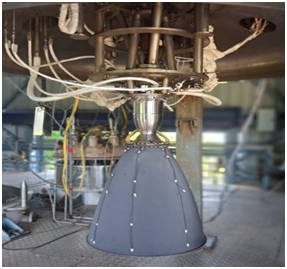
ISRO (Indian Space Research Organisation) has achieved a significant breakthrough in rocket engine technology. The Indian Space agency has developed a lightweight Carbon-Carbon (C-C) nozzle for rocket engines, which promises to enhance critical parameters and boost payload capacity for launch vehicles.
The development of a lightweight Carbon-Carbon (C-C) nozzle for rocket engines is an innovation by Vikram Sarabhai Space Centre (VSSC). The newly developed nozzle, when used in rockets, enhances certain parameters of the launch vehicle, such as — Thrust levels, Specific impulse, Thrust-to-weight ratios, among others.
Carbon-Carbon (C-C) nozzles offer several advantages over traditional materials when used in rocket engines. C-C nozzles provide a significant weight reduction compared to metallic nozzles. These are approximately 50% lighter than their metallic counterparts. This weight reduction is crucial for optimizing the performance of upper- stage and in-space liquid rocket engines.
Moreover, these C-C nozzles exhibit improved thermal design margins where in these nozzles can withstand temperatures ranging from 500°F to 1500°F. In contrast, traditional metallic nozzles have limitations due to their material properties.
By utilizing advanced materials like Carbon-Carbon (C-C) Composites, this innovation significantly enhances the payload capacity of launch vehicles.
Properties of the C-C Nozzle:
- Low density
- High specific strength
- Excellent stiffness
- Retains mechanical properties even at elevated temperatures.
- Special Coating: The C-C nozzle features a special anti-oxidation coating of Silicon Carbide, extending its operational limits in oxidizing environments.
 |
Significance of this new technology is a breakthrough, particularly beneficial for ISRO's Polar Satellite Launch Vehicle (PSLV). The current PSLV employs twin engines with nozzles made from Columbium alloy. By replacing these metallic divergent nozzles with C-C counterparts, a mass reduction of approximately 67% can be achieved.
This substitution is projected to increase the payload capability of the PSLV by 15 kg, a notable enhancement for space missions.
A 60-second hot test (video below) was conducted at the High-Altitude Test (HAT) facility in ISRO Propulsion Complex (IPRC), Mahendragiri in Odisha on March 19, confirming the system's performance and hardware integrity. This breakthrough holds great promise for India's space exploration endeavors.
Applications
C-C nozzles are particularly beneficial for cryogenic upper stage engines, in-space engines, ascent/descent lander engines, and even nuclear engines.For example, replacing metallic divergent nozzles with C-C counterparts in the PSLV (Polar Satellite Launch Vehicle) can increase payload capability by approximately 15 kg.
In a conclusion, Carbon-Carbon nozzles offer a compelling combination of weight reduction, improved thermal performance, and design flexibility, making them a valuable choice for advanced rocket propulsion systems.







 IndianWeb2.com is an independent digital media platform for business, entrepreneurship, science, technology, startups, gadgets and climate change news & reviews.
IndianWeb2.com is an independent digital media platform for business, entrepreneurship, science, technology, startups, gadgets and climate change news & reviews.
No comments
Post a Comment